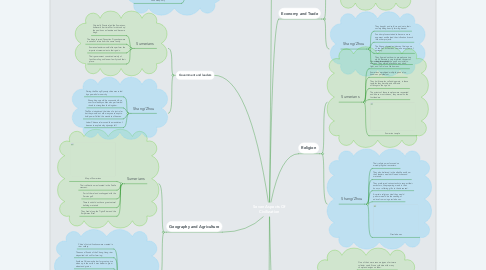
1. Social Structure and Family Life
1.1. Sumerians
1.1.1. Large land owners and wealthy mearchants were below the kings and priests
1.1.2. Under the large land owners and merchants were the majority of the Sumerians population it consisted of farmers, artisans, and laborers
1.1.3. At the top of the hierarchy is the king and priests
1.1.4. Men and Women have distinct roles with the men having political roles and women taking care of the children
1.2. Shang/Zhou
1.2.1. During the Shang dynasty china was ruled by a monarchy lead by kings and nobles.
1.2.2. Most people farmed, and eventualy had the free time to perform other tasks.
1.2.3. The most wealthy and top of the line families participated hunting for sport and collecting arts or expensive bronze/jade vases.
1.2.4. The very top of the social structure was the king and his family, who will most likely become the next rulers of the civilization.
2. Science and Technology
2.1. Sumerians
2.1.1. They developed a math system around the number 60 which we still use in our time system today.
2.1.2. They invented the wheel which was use for a variety of vehicles.
2.1.3. Learned how to make bronze to make stronger tools and weapons.
2.1.4. They Learned and used advanced geometry to build elaborate structures such as sewers.
2.1.5. Sumerian bronze weapon
2.2. Shang/Zhou
2.2.1. The development of writing started if closely to oracle bones.
2.2.2. Artists used bronze to make things such as vases.
2.2.3. The Zhou learned to use iron strengthening there armies.
2.2.4. The Zhou built Roads and canals.
2.2.5. Zhou weaponry
3. Geography and Agriculture
3.1. Sumerians
3.1.1. Map of Sumerians
3.1.2. Their civilization was located in the Fertile crescent.
3.1.3. Part of there land overlapped with the Persian gulf
3.1.4. There lands did not have great natural building materials
3.1.5. They lived along the Tigris River and the Eurphrares River
3.2. Shang/Zhou
3.2.1. China's first civilizations were created in river valleys.
3.2.2. The annual floods of the Chang Jiang river deposited rich soil for farming.
3.2.3. Southern China was better for growing rice when up in the north it was better to grow wheat and grains.
3.2.4. The large mountains and hills protected it from invasions.
3.2.5. Shang/Zhou Area
4. Government and leaders
4.1. Sumerians
4.1.1. Originally Priests ruled the Sumerians, however after time War lords took up the positions as leaders and became kings.
4.1.2. The kings formed Dynasties. Dynasties were a series of rulers from the same family.
4.1.3. Sumerian leaders would often perform the important ceremonies to their gods.
4.1.4. Their government consisted mainly of families ruling until a new family took their place.
4.2. Shang/Zhou
4.2.1. During the Shang Dynasty china was ruled by a powerful monarchy.
4.2.2. Shang kings would be surrounded by a court or wealthy nobles who performed rituals to strengthen the kingdom.
4.2.3. The Zhou introduced the idea of a just ruler but they would not allow anyone corrupt to hold power Called the mandate of heaven.
4.2.4. Latter Chinese rulers used the mandate of heaven to explain why dynastys fell.
5. Economy and Trade
5.1. Sumerians
5.1.1. As trade enriched sumer a high class rose up.
5.1.2. Sumerians didn't have the same amount of natural resources as the other settlements
5.1.3. The Sumerians Got most of their building materials through trade by trading woven textiles.
5.1.4. They traded mainly with people across southwest asia.
5.2. Shang/Zhou
5.2.1. They bought and sold crops due to their society being heavily farming based.
5.2.2. Food surpluses started to become more apparent and helped the civilization branch into other projects.
5.2.3. The Shang showed evidence of being one of the first civilizations to make a system of currency.
5.2.4. They figured out how to properly use iron which became a very important aspect of their community.
6. Religion
6.1. Sumerians
6.1.1. Sumerians thought of the gods as similar to humans. They were believed to eat, drink, fight, and fall in love like humans.
6.1.2. Sumerians worshiped multiple gods ,also known as polytheism.
6.1.3. They built temples called ziggurats, in these temples they worshiped and made offerings to their gods.
6.1.4. The priests of these temples were respected and above most citizens, they were also the first leaders.
6.1.5. Sumerian temple
6.2. Shang/Zhou
6.2.1. Their religion was focused on worshiping their ancestors.
6.2.2. They also believed in the afterlife and how their leaders would still need riches and materials.
6.2.3. They preformed various tasks to respect their ancestors, like preparing meals in their honor, or offering gifts to the deceased.
6.2.4. A certain religious ritual they would perform would be the seeking of advice from using oracle bones.
6.2.5. Oracle bones
7. Arts and Education
7.1. Sumerians
7.1.1. One of their more renown types of art were cylinder seals. Stone cylinders with many complex designs on them.
7.1.2. Sumerians used a few styles in their architecture. For instance arches ramps and columns.
7.1.3. Learned how to make wheels for vehicles like carts and small cars.
7.1.4. Sumerians also used the wheel for making pottery.
7.1.5. Cylinder seal
7.2. Shang/Zhou
7.2.1. The Shang made vases out of bronze and jade, the wealthy collected these.
7.2.2. They learned how to write/use a language and also related to writing closely to oracle bones.
7.2.3. They produced a detailed calender based on the cycle of the moon.
7.2.4. Shang bronze art

